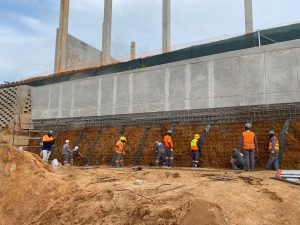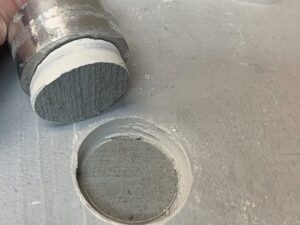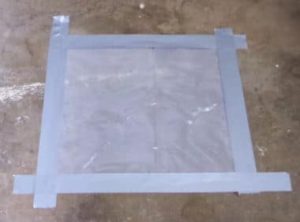By Carl White
Colloidal silica post-placement pozzolan technology differs to commonly available materials that are marketed as corrosion inhibitors.
Our technologies consist of post-initial set applied colloidal silica. Considering colloidal silica post-placement pozzolan technology’s extremely small particle size, it has a tremendous amount of pozzolanic potential. The pozzolanic reaction of colloidal silica post-placement pozzolan technology is greater than even that of undensified silica fume. 1 This pozzolanic reaction takes place in the capillary voids and pore space in concrete. In this way, it fills the void space with calcium-silicate hydrate (C-S-H). C-S-H is the same reaction product that provides concrete with its strength and durability traits. Because it restricts movement of water through concrete even under hydrostatic pressure, colloidal silica post-placement pozzolan technology is widely used as a waterproofing agent. This waterproofing action considerably reduces water-borne contaminant ingress, including chloride transport.
Commonly available materials that are marketed as “corrosion inhibitors” typically consist of calcium nitrite and are promoted to chemically alter the corrosion process. Corrosion inhibitor suppliers use descriptions like “prevents salt attack” throughout the marketing material of their products. In doing so, they imply that their products are a permanent solution to corrosion. Laboratory studies have shown that corrosion inhibitors only extend the initiation period. Only a few of these products provide a short delay in corrosion initiation. 2,3 Moreover, once corrosion has started, the effectiveness of corrosion inhibitors is less significant than previously reported. 4
Colloidal silica and concrete durability
Colloidal silica post-placement pozzolan technology improves the durability of concrete. This is through its ability to restrict the movement of water and chlorides, which is particularly important when considering reinforcing steel corrosion.
Chlorides are a major cause of reinforcing steel corrosion, the primary reason for the failure of reinforced concrete structures. They penetrate the passive layer around the rebar. This passive layer is a film created by the high pH (alkalinity) of concrete through which oxygen cannot penetrate. A prevailing theory is that chloride ions increase the solubility of the passive layer, causing it to give way at a threshold concentration. 5 Once the passive layer has been penetrated, the corrosion action no longer needs chlorides to progress. This action is typically self-sustaining, requiring only the rebar, water and oxygen to progress. After this occurs, the pore structure of the concrete and the electrical resistivity that this structure provides6 become the primary focus.
Performance of colloidal silica tested
The performance of colloidal silica post-placement pozzolan technology has been tested in chloride bulk diffusion situations in conventional concrete by three laboratories.
Chloride bulk diffusion involves ponding salt water on top of concrete and testing the chloride concentrations at various depths according to AASHTO T-259 or ASTM C1543. This information is used to derive an average diffusion coefficient (D) that can be used to calculate the amount of time that it will take for chlorides to reach reinforcing steel and penetrate the passive layer around it. These predictions are modelled with software, such as Life 365. If the diffusion coefficient can be reduced by years, time can be added to the period it takes for chlorides to reach the rebar. This extends a structure’s life expectancy. The results of these tests are presented in Table 1.
Colloidal silica combat reinforcing steel corrosion
Colloidal silica post-placement pozzolan technology combats corrosion of concrete reinforcing steel in several ways. Firstly, colloidal silica post-placement pozzolan technology can significantly slow the transmission of chlorides through the concrete. This potentially extends the corrosion initiation period by years compared to untreated concrete. Secondly, colloidal silica post-placement pozzolan technology waterproofs concrete. This reduces access of the corrosion reaction to water and significantly restricts oxygen availability. Moreover, colloidal silica post-placement pozzolan technology can increase the electrical resistivity of the concrete to levels where corrosion is unlikely to occur. SCP products can, therefore, provide an advantage over corrosion inhibitors. This is by affecting the initiation period and removing some of the water and oxygen that is needed for corrosion to continue.
In any corrosion mitigation project, SCP recommends testing levels of chlorides at various depths. This is in addition to performing half-cell and surface resistivity measurements before and after treatment. Results should be evaluated to determine if treated results are consistent with requirements for reinforcing steel preservation for the project.
Table 1: Chloride Diffusion Reduction Percentage with SCP Treatment
| Study | W/cm Ratio of Concrete | Reduction in Chloride Diffusion Coefficient (D), % |
| Middle Tennessee State
University |
0.57 | 69 |
| University of Tennessee at
Chattanooga (average of 7 tests)7 |
0.45 | 69 |
| Tennessee Department of
Transportation |
0.40 | 75 |
| Florida Department of
Transportation |
0.40 | 55 |
The reduction in chloride diffusion rate provided by SCP treatments has the potential to add years of time in the field before chlorides reach reinforcing steel.
__________________________
1 Singh, L.P., Karade, S.R., Bhattacharyya, S.K., Yousuf, M.M., & Ahalawat, S. (2013) “Beneficial role of
nanosilica in cement based materials – a review,” Construction and Building Materials 47, 1069-1077.
2 Neville, Adam (1995) “Chloride Attack of Reinforced Concrete: An Overview.” Materials and Structures
28, 63-70.
3 Trepanier, SM; Hope, B.B.; Hansson, C.M. (2001) “Corrosion inhibitors in concrete Part III. Effect on
time to chloride-induced corrosion initiation and subsequent corrosion rates of steel in mortar” Cement and
Concrete Research 31, 713-718.
4 Goyal, Arpit; Poya, H.S.;Ganjian, Eshmaiel; Claisse, Peter (2018) “A review of corrosion and protection
of steel in concrete” Arabian Journal for Science and Engineering 22-Feb, 2018.
5 Soylev, T.A.;Richardson, M.G. (2008) “Corrosion inhibitors for steel in concrete: State-of-the-art report.”
Construction and Building Materials 22, 609-622
6 Singh, L.P., Karade, S.R., Bhattacharyya, S.K., Yousuf, M.M., & Ahalawat, S. (2013) “Beneficial role of
nanosilica in cement based materials – a review,” Construction and Building Materials 47, 1069-1077.
7 Collet, P., Rollins, A.B., Andres, V. (2016) “Concrete Porosity Reduction by Colloidal Silica Nano
Technology” Conference Proceedings, CONSEC 16, Lecco, Italy.






